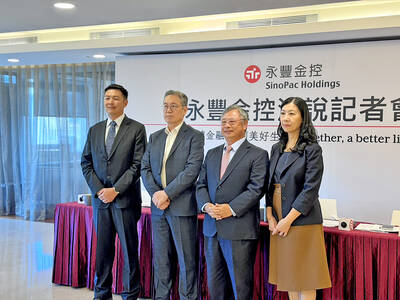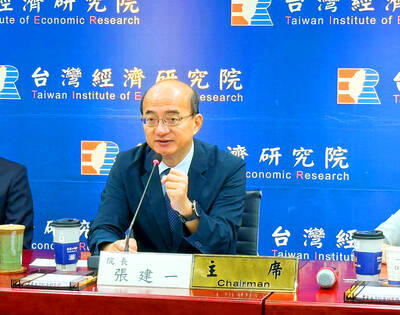Msscorps Co (汎銓科技) yesterday said it expects silicon photonics-related and artificial intelligence (AI) analysis services to fuel revenue growth, as it benefits from the AI boom.
The company provides advanced semiconductor materials analysis and failure analysis to semiconductor firms, including Taiwan Semiconductor Manufacturing Co (台積電).
The Hsinchu-based firm expects revenue from silicon photonics and AI analyses to double or triple in April next year, compared with this month, Msscorps chairman Gino Leou (柳紀綸) told reporters.

Photo courtesy of Msscorps Co
“We are seeing strong growth momentum from this segment,” Leou said. “Msscorps is leading its peers in providing comprehensive services from chip testing, [material and failure] analysis to co-packaged optics [CPO] services.”
CPO technology has become a widely discussed topic among semiconductor analysts and investors after Nvidia Corp last month said that it planned to introduce the new technology for its next-generation switch platforms for server racks.
However, the AI giant did not say it would adopt CPO technology for its next graphics processing unit (GPU), dubbed Rubin, as most analysts expected.
Msscorps expects to see explosive growth in silicon photonics-related and AI chip testing and inspection services from the second half of this year.
The new business is expected to gradually increase its contribution to overall revenue from 5.5 percent last year to 10 percent in 2027, it said.
Another growth driver would be its advanced inspection and analysis services for angstrom-scale process technology, which is the major revenue source for the firm, Leou said.
Revenue from advanced inspection and analysis services for cutting-edge process technologies would expand 20 to 30 percent through April next year, he said.
To meet a key customer’s demand, the company yesterday held a topping ceremony for a new facility in Hsinchu to house a new inspection equipment — a spherical aberration corrected scanning transmission electron microscope (Cs-STEM), which costs at least US$4 million.
Msscorps expects to start utilizing the new Cs-STEM in August.
Semiconductor material and failure analyses are vital for chipmakers to ramp up production yield, as chip design migrates to smaller nodes, such as 16 angstroms or 14 angstroms, and semiconductor structure becomes more complex. Inspection and metrology tools are utilized to make sure each manufacturing step is optimized.
By using automated transmission electron microscope-based metrology instruments, Msscorps can provide accurate and timely semiconductor material inspection, lower manufacturing costs and shorten the product development cycle.
“We have invested heavily on sourcing new equipment. Those investments would pay off from the second half of this year,” Leou said.
The company is optimistic about this year’s revenue prospects, as overseas markets, including China, the US and Japan, are to start generating revenue later this year, Leou said.
Revenue this year is forecast to surpass last year’s NT$1.97 billion (US$59.54 million), he said.
The company is also scouting a suitable site to build a new laboratory in Germany or the Czech Republic to provide real-time services, as requested by its key customer.

SETBACK: Apple’s India iPhone push has been disrupted after Foxconn recalled hundreds of Chinese engineers, amid Beijing’s attempts to curb tech transfers Apple Inc assembly partner Hon Hai Precision Industry Co (鴻海精密), also known internationally as Foxconn Technology Group (富士康科技集團), has recalled about 300 Chinese engineers from a factory in India, the latest setback for the iPhone maker’s push to rapidly expand in the country. The extraction of Chinese workers from the factory of Yuzhan Technology (India) Private Ltd, a Hon Hai component unit, in southern Tamil Nadu state, is the second such move in a few months. The company has started flying in Taiwanese engineers to replace staff leaving, people familiar with the matter said, asking not to be named, as the

The prices of gasoline and diesel at domestic fuel stations are to rise NT$0.1 and NT$0.4 per liter this week respectively, after international crude oil prices rose last week, CPC Corp, Taiwan (台灣中油) and Formosa Petrochemical Corp (台塑石化) announced yesterday. Effective today, gasoline prices at CPC and Formosa stations are to rise to NT$27.3, NT$28.8 and NT$30.8 per liter for 92, 95 and 98-octane unleaded gasoline respectively, the companies said in separate statements. The price of premium diesel is to rise to NT$26.2 per liter at CPC stations and NT$26 at Formosa pumps, they said. The announcements came after international crude oil prices

SinoPac Financial Holdings Co (永豐金控) is weighing whether to add a life insurance business to its portfolio, but would tread cautiously after completing three acquisitions in quick succession, president Stanley Chu (朱士廷) said yesterday. “We are carefully considering whether life insurance should play a role in SinoPac’s business map,” Chu told reporters ahead of an earnings conference. “Our priority is to ensure the success of the deals we have already made, even though we are tracking some possible targets.” Local media have reported that Mercuries Life Insurance Co (三商美邦人壽), which is seeking buyers amid financial strains, has invited three financial

CAUTION: Right now, artificial intelligence runs on faith, not productivity and eventually, the risk of a bubble will emerge,’ TIER economist Gordon Sun said Taiwanese manufacturers turned more optimistic last month, ending a five-month streak of declining sentiment as concerns over US tariffs, currency volatility and China’s overcapacity began to ease, the Taiwan Institute of Economic Research (TIER) said yesterday. The manufacturing business confidence index rose 1.17 points from June to 86.8, its first rebound since February. TIER economist Gordon Sun (孫明德) attributed the uptick to fading trade uncertainties, a steadier New Taiwan dollar and reduced competitive pressure from Chinese producers. Taiwan’s semiconductor industry is unlikely to face significant damage from Washington’s ongoing probe into semiconductors, given the US’ reliance on Taiwanese chips to power artificial